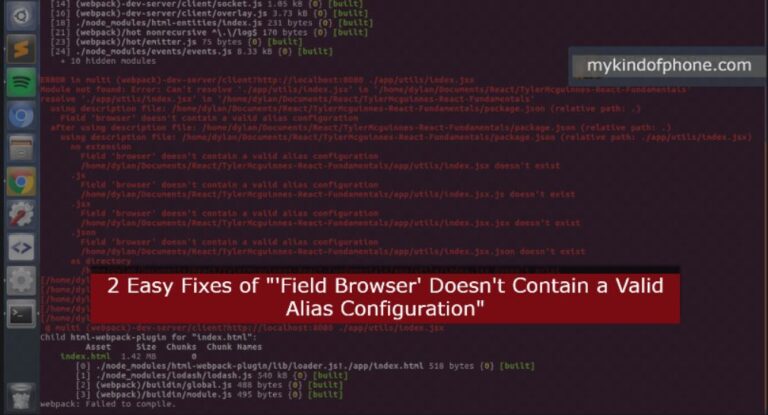Did you ever find yourself in a situation where you get an error like this one while navigating around the Front End application of your project: “Field ‘Browser’ doesn’t contain a valid alias configuration“? And, this perplexing problem usually stems up while working with JavaScript build tools, specifically the webpack-2, which can stall your development. But it is actually worse than walking in a maze with the wrong path of imports and even syntax errors in front of you.
In this guide, we shall proceed on an exploration to discover the details of this error. We will first look at some of the causes; from expired browsers to the configuration of mispackage. JSON files. After that, we will proceed to understand the steps that should be taken or logical sequences that may be followed to get the project working again.
Whether you’re having a problem with a module not found, having an issue with style-loaders or have no clue on how to go about the react hot loaders, we have the solution. Therefore, sit, fasten your seat belts, and prepare to turn that annoying error message into history!
Getting to Know the “Field ‘Browser’ Doesn’t Contain a Valid Alias Configuration Error”

The ‘Field Browser’ error is a kind of gremlin in the intricacies of web development. It usually comes in handy when Webpack, our reliable JavaScript build tool, gets lost in files and configurations labyrinth. This error is commonly seen in forms like “Field ‘Browser’ doesn’t contain valid alias configuration“, and another form of a “Module not found” message.
This kind of error can arise at any moment but it is most frequent when coming across React Native Web applications. Webpack is now acting like Webpack in a real maze where it cannot locate very important modules like ‘RCTNetworking’.
The root cause often lies in the package.json file, where the ‘browser’ field might be misconfigured or missing entirely. It’s like trying to follow a map with crucial landmarks erased. Webpack attempts to resolve file paths using different extensions (.js, .jsx, .json, .wasm), but comes up empty-handed each time.
READ MORE of our Articles: 2 Easy Ways to Charge a BLU Tank Xtreme 4.0 Phone, Why your Phone Battery is Going Down While Charging? {Fixed} and much more on our website mykindofphone.com
Diagnosing the Root Cause
To get to the bottom of this pesky error, developers need to put on their detective hats. The culprit often lurks in the package.json file, where the ‘browser’ field might be playing hide and seek. It’s like trying to find a needle in a haystack, but the needle is actually a misplaced comma or a missing bracket.
The error typically stems from Jest-resolve using ‘browser-resolve’ internally. This process relies on the ‘basedir’ option when dealing with relative file paths. For instance, if a require statement looks like ‘require(‘../component/utils’);’, the options.basedir parameter gets set to ‘../marko/dist/runtime’. This basis is what ‘browser-resolve’ uses to hunt down package.json files and check for browser properties.
The plot thickens when we realize that ‘browser-resolver’ stops its search at the first package.json it finds. It’s like a lazy detective who gives up after checking the first suspect. This can lead to the actual file in the node_modules folder being overlooked, even if it has the correct configuration.
Step-by-Step Solutions for “Field ‘Browser’ Doesn’t Contain a Valid Alias Configuration”

- Check package.json: Ensure the ‘browser’ field is correctly configured. For example:
"browser": {
"buffer": false,
"stream": "./node_modules/stream-browserify/index.js",
"src/index.node.js": "src/index.browser.js"
} - Update webpack.config.js:
- Add proper extensions:
resolve: { extensions: ['.ts', '.js', '.jsx', '.json', '.wasm'] } - Set correct entry point:
entry: path.resolve(__dirname, './src/js/index.js') - Add aliases if needed:
resolve: {
alias: {
'@store': path.resolve(__dirname, '../src/store'),
'react': path.resolve('./node_modules/react')
}
}
- Add proper extensions:
- Fix import statements:
- Use relative paths:
import DoISuportIt from './components/DoISuportIt' - Check for case sensitivity:
import Dashboard from './Dashboard/dashboard'
- Use relative paths:
- Verify dependencies:
- Install missing packages:
npm install package-name - Check for broken symlinks in linked packages
- Install missing packages:
- Docker users: Try
docker-compose downthendocker-compose up
Remember, always double-check file names, paths, and configurations!
Conclusion
Navigating the maze of the “Field ‘Browser’ Doesn’t Contain a Valid Alias Configuration” error can be a real headache for developers. This guide has shed light on the common causes and offered practical solutions to tackle this issue head-on. By diving into package.json configurations, tweaking web pack settings, and double-checking import statements, developers now have a toolkit to resolve this error and get their projects back on track.
In the end, dealing with such errors is part and parcel of the coding journey. This walkthrough not only helps to solve this specific problem but also enhances the overall understanding of how build tools and module resolution work. Armed with these insights, developers can approach similar issues with more confidence, turning potential roadblocks into stepping stones for growth and learning in their coding adventures.
FAQs
Currently, we don’t have any frequently asked questions related to the article “How to Resolve ‘Field Browser Doesn’t Contain a Valid Alias Configuration’.” we will get back soon or you can contact us for that. we will update this ASAP.

